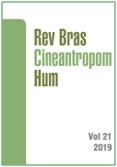Differences between training and game loads in young basketball players
DOI:
https://doi.org/10.1590/1980-0037.2019v21e59840Abstract
The same training stimulus can provide different physiological adaptations for athletes of the same team. The aim of this study was to compare training and game loads in young male basketball players. Data were obtained from 4 training sessions and one game session using Polar Team Pro equipment. Physiological data (HR) were used to monitor internal responses through Edwards' TRIMP, and data on distance traveled by the player on the court (External Training Load). To observe differences between eTRIMP, HR max and distance traveled, the T-Test was used for paired samples. The mean internal training load, according to Edwards' TRIMP, for the four training sessions was 132 ± 69. Mean HR max and distance traveled values were 143 ± 67 and 2.273 ± 1170, respectively. Regarding game load, Edwards' TRIMP, maximum HR and distance traveled were 108 ± 33, 199 ± 4 and 2.240 ± 617, respectively. No statistically significant differences were found between the mean values of training sessions compared to the game session in relation to the Edwards’ TRIMP measures and distance traveled, but HR max was significantly higher during the game compared to training. It was concluded that the loads applied during training are similar to those applied in the game.
References
Rose Junior D, Tricoli V. Basquetebol: do treino ao jogo. Manole; 2017.
Bourdon P, Cardinale M. Monitoring Athlete Training Loads: Consensus Statement. J Sport 2017;12(2)161–170.
Manzi V, D’Ottavio S, Impellizzeri FM, Chaouachi A, Chamari K, Castagna C. Profile of Weekly Training Load in Elite Male Professional Basketball Players. J Strength Cond Res 2010; 24(5):399–406.
Borresen J, Lambert MI. The quantification of training load, effect on performance. Sport Med 2009;39(9):779–795.
Foster C, Florhaug JA, Franklin J, Gottschall L, Hrovatin LA, Parker S, et al. A new approach to monitoring exercise training. J Strength Cond Res 2001;15(1):109-115.
Impellizzeri FM, Rampinini E, Coutts AJ, Sassi A, Marcora SM. Use of RPEbased training load in soccer. Med Sci Sports Exerc 2004; 36(6):1042–1047.
Fox JL, Scanlan AT, Stanton R. A Review of Player Monitoring Approachesin Basketball: Current Trends and Future Directions. J Strength Cond Res 2017;31(7):2021–2029.
Passfield L, Hopker JG. A Mine of Information: Can Sports Analytics Provide Wisdom From Your Data? Int J Sports Physiol Perform 2017; 12(7):1–17.
Montgomery PG, Pyne DB, Minahan CL. The physical and physiologicaldemands of basketball training and competition. Int J Sports Physiol Perform 2010;5(1):75–86.
Murray A. Managing the Training Load in Adolescent Athletes Athlete Development: A Modern Phenomenon? Developing Athletes With Sound Scientific Principles. Int J Sports Physiol Perform 2017;12(2):42–49.
Lupo C, Tessitore A, Gasperi L, Gomez MAR. Session-RPE for quantifying the load of different youth basketball training sessions. Biol Sport 2017;34(1):11–17.
Edwards S. The Heart Rate Monitor Book. Medicine & Science in sports &Exercise; 1994.
Shargal E, Kislev-Cohen R, Zigel L, Epstein S, Pilz-Burstein R, Tenenbaum G. Age-related maximal heart rate: examination and refinement of prediction equations. J Sports Med Phys Fitness 2014; 55(10):1207–1218.
Scanlan AT, Wen N, Tucker PS, Borges NR, Dalbo VJ. Training Mode’s Influence on the Relationships between Training-Load Models during Basketball Conditioning. Int J Sports Physiol Perform 2014; 9(5):851–856.
Ben Abdelkrim N, Castagna C, Jabri I, Battikh T, El Fazaa S, Ati J El. Activity Profile and Physiological Requirements of Junior Elite Basketball Players in Relation to Aerobic-Anaerobic Fitness. J Strength Cond Res 2010; 24(9):2330–2342.
Torres-Ronda L, Angel R, Llabres-Tores I, Ias HB, Schelling AX. Position dependent cardiovascular response and time-motion analysis during training drills and friendly matches in elite male basketball players. J Strength Cond Res 2016;30(1):60–70.
Bangsbo J, Mohr M, Krustrup P. Physical and metabolic demands of training and match-play in the elite football player. J Sports Sci 2006; 24(7):665–674.
Henderson B, Cook J, Kidgell DJ, Gastin PB. Game and Training Load Differences in Elite Junior Australian Football. J Sports Sci Med 2015;14(3):494–500.
Carlo C, Impellizzeri FM, Chaouachi A, Nidhal BA, Manzi V. Physiological responses to ball-drills in regional level male basketball players. J Sports Sci 2011;29(12):1329–1336.
Schelling X, Torres L. Accelerometer load profiles for basketball-specific drills in elite players. J Sport Sci Med 2016;15(4):585-591.



